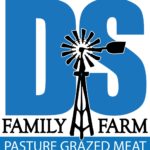Worried about what you are "really" eating? Have peace of mind with pasture grazed meats.
Soil Carbon – Recorded History
We recently experienced the hottest July in “recorded history”… since around 1890! I don’t know how long Nebraska has been around but I am pretty sure at least once Nebraska was under water and where our farm is located, at one time it was under a glacier (see photo). Whether you believe the earth is about 10,000 years old or millions of years old, recorded history of Nebraska is just a blip on the timeline.

Historic Soil Carbon in Nebraska
Nebraska’s state soil is the “Holdrege soil” (find your state soil here).
- Holdrege soil is classified in the Mollisol soil order which means:
- the soil developed under grasslands
- the soil has a distinct dark humus-rich top layer
- (refer to previous post discussing “humus”)
Carbon stored in these soils create this dark rich color (think charcoal). These dark humus-rich soils occur through all the tall-grass prairie region of the U.S. forming what is called the “North American Bread Basket” (very productive soils).
What happened to these carbon rich soils?
A great source of soil history is found in old government soil surveys. According to the 1917 Phelps County Soil Survey (home of the Holdrege soil), prior to 1885 only a small portion of these soils had been “plowed, but by 1895 probably 60 percent had been broken up.”
Reading through one of the oldest soil surveys in Nebraska (Grand Island 1903), we find a silty loam soil recorded with only 2.6% organic matter. WOW, that does not seem like a carbon rich soil after only 10 to 20 years of being broken up to farm. Grazing specialist Dale Strickler from Kansas has postulated that over grazing of our prairies during the 1800’s (open range period) depleted soil carbon significantly. This small piece of data from 1903 would tend to support that kind of thinking.
Now add 125+ years of plowing/tillage to these soils and we should be thankful for what carbon we have left in our soils. In spite of human activity, many of Nebraska soils today still maintain 2% organic matter and higher.
But what about the bison?
Didn’t the grazing bison build the soils that became the bread basket of the USA? How could overgrazing degrade the soils?
The key difference is how the grazing occurred. Overgrazing is not a function of how many animals are on an area. Overgrazing is a function of time, especially in the ‘return to graze’ time factor.
Large bison herd records indicate heavy animal impact (depending on the season) and the herds moving on. As the herds moved on, prairies recovered, grasslands moved CO2 from the air into ground forming rich dark soils. When the herds returned the grass had fully recovered. Natures way to insure a future harvest.
Open free range encouraged humans to over use prairies with cattle. Grazing cattle stayed around too long and came back to soon, before the grass fully recovered. This overuse resulted in loss of carbon from the soil into the atmosphere.
Regenerative Grazing
To rebuild carbon in our grassland soils we simply reintroduce natures pattern of grazing. Appropriate animal impact (depending on the season) followed by rest (time) for the grasses to fully recover prior to the next grazing event.
It is amazing how prairies respond with time, just a single growing season, when given an opportunity to recover. For example photos of recovery after rest, please revisit our September 2016 post (Animal impact while farming grass).
In this post we have introduced the term soil organic matter while discussing soil carbon. In our next post we will explore the difference between soil carbon and soil organic matter. Stay tuned and feel free to add a question or comments to our DS Family Farm FaceBook page.




